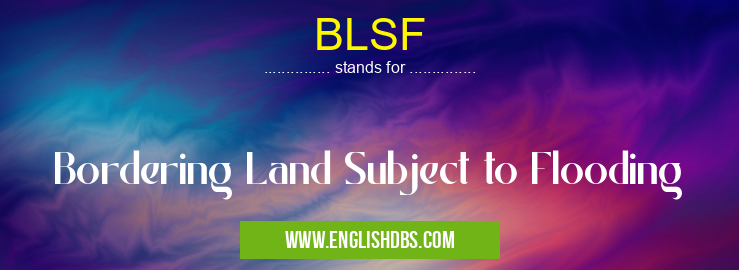What does BLSF mean in UNCLASSIFIED
"BLSF" stands for Bordering Land Subject to Flooding. It is a term used in the context of zoning and land use planning to identify areas that are at risk of flooding due to their proximity to water bodies or other sources of flooding. Understanding BLSF is crucial for property owners, developers, and policymakers to make informed decisions about land use and development in flood-prone areas.

BLSF meaning in Unclassified in Miscellaneous
BLSF mostly used in an acronym Unclassified in Category Miscellaneous that means Bordering Land Subject to Flooding
Shorthand: BLSF,
Full Form: Bordering Land Subject to Flooding
For more information of "Bordering Land Subject to Flooding", see the section below.
What is BLSF?
BLSF refers to land parcels that are adjacent to or share a boundary with areas designated as floodplains or flood hazard zones. These areas may include rivers, streams, lakes, or coastal zones that have a high probability of flooding during heavy rains, snowmelt, or other events that cause water levels to rise. BLSF properties face an elevated risk of flooding, which can result in damage to structures, infrastructure, and the environment.
Significance of BLSF
Identifying BLSF areas is essential for several reasons:
- Flood Risk Assessment: BLSF designations help assess the flood risk associated with properties and guide development decisions to minimize potential damage and loss of life.
- Zoning Regulations: Local governments and planning authorities use BLSF information to establish zoning regulations that restrict certain types of development in flood-prone areas.
- Insurance Requirements: Properties located within BLSF zones may be subject to mandatory flood insurance requirements to protect against financial losses in the event of flooding.
- Property Value: BLSF designations can impact property values as potential buyers may be concerned about flood risks and the associated costs of mitigation and insurance.
Responsibilities of Property Owners and Developers
Property owners and developers have specific responsibilities related to BLSF:
- Due Diligence: It is their responsibility to determine if their property is located within a BLSF zone before making any development decisions.
- Compliance with Regulations: They must adhere to zoning regulations and building codes for flood-prone areas, which may include restrictions on construction heights, materials, and drainage systems.
- Flood Mitigation Measures: They may need to implement flood mitigation measures, such as elevating structures, installing flood barriers, or creating green infrastructure to reduce the risk of damage from flooding.
Essential Questions and Answers on Bordering Land Subject to Flooding in "MISCELLANEOUS»UNFILED"
What is Bordering Land Subject to Flooding (BLSF)?
BLSF refers to land that is adjacent to or near a body of water, such as a river, lake, or ocean, and has a significant risk of flooding. This designation is typically given to land that has been determined to be within a floodplain, which is an area that is likely to be inundated by floodwaters during a major storm event.
Why is BLSF important to consider when purchasing property?
BLSF is important to consider when purchasing property because it can significantly impact the value, insurability, and usability of the land. Flooding can cause substantial damage to structures and infrastructure, and it can also pose a safety hazard to residents. Additionally, BLSF may be subject to building restrictions and other regulations that can limit the use and development of the property.
What are the different types of BLSF?
BLSF can be classified into different types based on the level of flood risk. Common types of BLSF include:
- High-risk BLSF: This type of land has a high probability of flooding during a major storm event. It is typically located within the 100-year floodplain, which means that there is a 1% chance of flooding in any given year.
- Moderate-risk BLSF: This type of land has a moderate probability of flooding during a major storm event. It is typically located within the 500-year floodplain, which means that there is a 0.2% chance of flooding in any given year.
- Low-risk BLSF: This type of land has a low probability of flooding during a major storm event. It is typically located outside of the 500-year floodplain, but may still be subject to flooding in some circumstances.
How can I determine if a property is BLSF?
There are several ways to determine if a property is BLSF. One way is to check the Federal Emergency Management Agency (FEMA) flood maps. These maps show the areas that are at risk of flooding and can help you determine if a particular property is located within a floodplain. Another way to determine if a property is BLSF is to contact the local planning or zoning department. They can provide you with information about the flood risk for a particular property and any building restrictions that may apply.
Final Words: Understanding BLSF is vital for informed decision-making in flood-prone areas. By identifying and managing BLSF areas, property owners, developers, and policymakers can mitigate flood risks, protect property and infrastructure, and ensure the safety of communities. It is an essential aspect of responsible land use planning and sustainable development in flood-prone regions.
